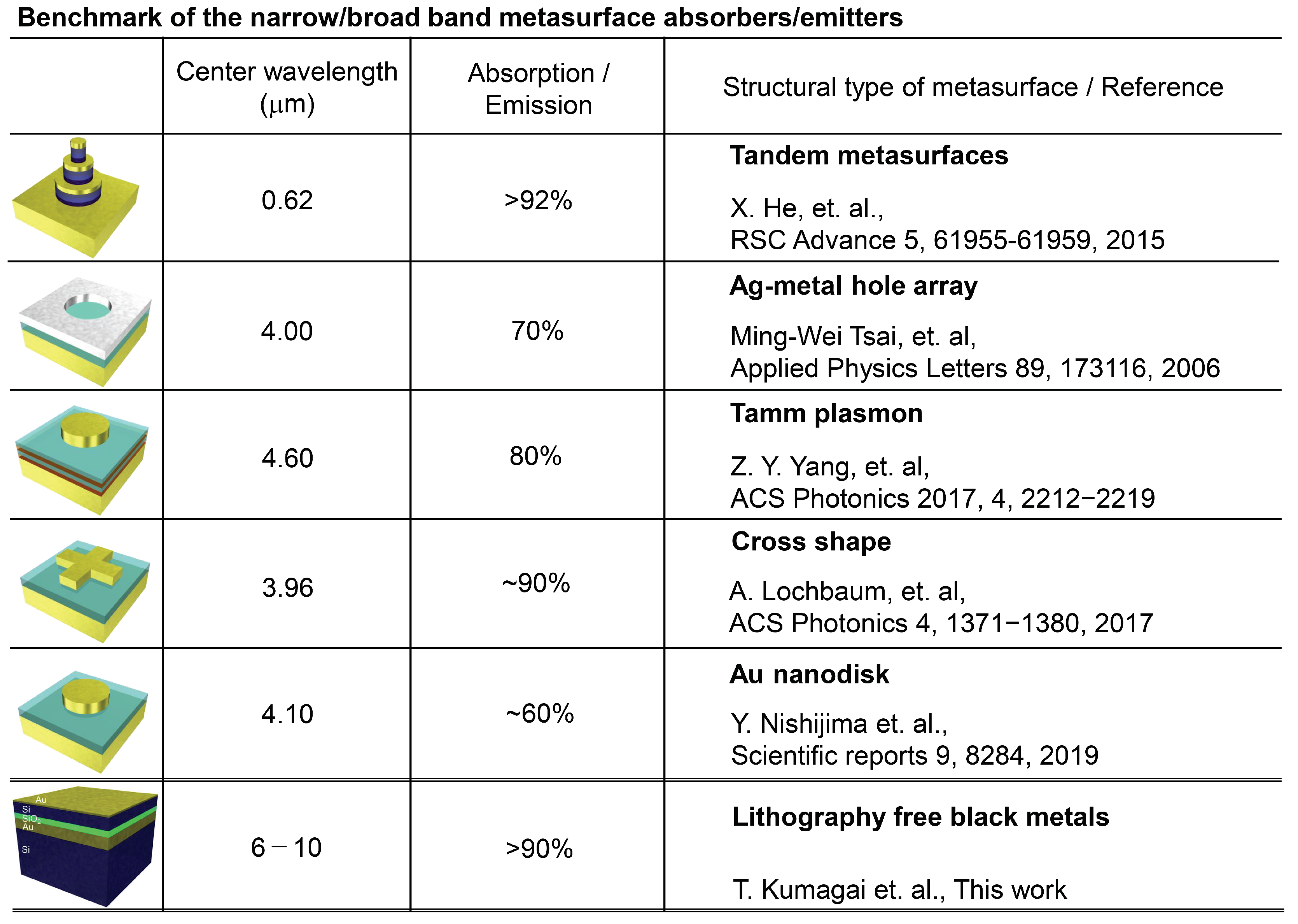Kirchhoff’s Thermal Radiation from Lithography-Free Black Metals
Abstract
1. Introduction
2. Experiments
2.1. Fabrication of Mid-Infrared (MIR) Black Metals
2.2. Numerical Simulation
3. Results and Discussion
3.1. Experimental Results
3.2. Numerical Simulations
3.3. The Effect of Adhesion Layer
3.4. Comparison to the Other Thermal Radiation Materials
4. Conclusions and Outlook
Author Contributions
Funding
Conflicts of Interest
References
- Nishijima, Y.; Balčytis, A.; Naganuma, S.; Seniutinas, G.; Juodkazis, S. Tailoring metal and insulator contributions in plasmonic perfect absorber metasurfaces. ACS Appl. Nano Mater. 2018, 1, 3557–3564. [Google Scholar] [CrossRef]
- Nishijima, Y.; Balčytis, A.; Naganuma, S.; Seniutinas, G.; Juodkazis, S. Kirchhoff’s metasurfaces towards efficient photo-thermal energy conversion. Sci. Rep. 2019, 9, 8284. [Google Scholar] [CrossRef] [PubMed]
- Beni, T.; Yamasaku, N.; To, N.; Okazaki, S.; Balčytis, A.; Seniutinas, G.; Juodkazis, S.; Nishijima, Y. Metamaterial for Hydrogen Sensing. ACS Sens. 2019, 4, 2389–2394. [Google Scholar] [CrossRef] [PubMed]
- Li, Z.; Butun, S.; Aydin, K. Large-Area, Lithography-Free Super Absorbers and Color Filters at Visible Frequencies Using Ultrathin Metallic Films. ACS Photonics 2015, 2, 183–188. [Google Scholar] [CrossRef]
- Bossard, J.A.; Lin, L.; Yun, S.; Liu, L.; Werner, D.H.; Mayer, T.S. Near-Ideal Optical Metamaterial Absorbers with Super-Octave Bandwidth. ACS Nano 2014, 8, 1517–1524. [Google Scholar] [CrossRef] [PubMed]
- He, X.; Yan, S.; Lu, G.; Zhang, Q.; Wu, F.; Jiang, J. An ultra-broadband polarization-independent perfect absorber for the solar spectrum. RSC Adv. 2015, 5, 61955–61959. [Google Scholar] [CrossRef]
- Ding, F.; Dai, J.; Chen, Y.; Zhu, J.; Jin, Y.; Bozhevolnyi, S.I. Broadband near-infrared metamaterial absorbers utilizing highly lossy metals. Sci. Rep. 2016, 6, 20452322. [Google Scholar] [CrossRef]
- Tsai, M.W.; Chuang, T.H.; Meng, C.Y.; Chang, Y.T.; Lee, S.C. High performance midinfrared narrow-band plasmonic thermal emitter. Appl. Phys. Lett. 2006, 89, 2–5. [Google Scholar] [CrossRef]
- Ustun, K.; Turhan-Sayan, G. Broadband LWIR and MWIR metamaterial absorbers with a simple design topology: Almost perfect absorption and super-octave band operation in MWIR band. J. Opt. Soc. Am. B 2017, 34, D86–D94. [Google Scholar] [CrossRef]
- Lobet, M.; Henrard, L. Metamaterials for Ultra-Broadband Super Absorbers Based on Plasmon Hybridization. In Proceedings of the IEEE 2014 8th International Congress on Advanced Electromagnetic Materials in Microwaves and Optics, Lyngby, Denmark, 25–28 August 2014; pp. 190–192. [Google Scholar]
- Zhong, Y.K.; Fu, S.M.; Huang, W.; Rung, D.; Huang, J.Y.; Parashar, P.; Lin, A. Polarization-selective ultra-broadband super absorber. Opt. Express 2017, 25, A124–A133. [Google Scholar] [CrossRef]
- Nishijima, Y.; Nigorinuma, H.; Rosa, L.; Juodkazis, S. Selective enhancement of infrared absorption with metal hole allays. Opt. Mater. Express 2012, 2, 1367–1377. [Google Scholar] [CrossRef]
- Nishijima, Y.; Adachi, Y.; Rosa, L.; Juodkazis, S. Augmented sensitivity of an IR-absorption gas sensor employing a metal hole array. Opt. Mater. Express 2013, 3, 968–976. [Google Scholar] [CrossRef]
- Nishijima, Y.; Suda, S.; Seniutinas, G.; Balčytis, A.; Juodkazis, S. Plasmonic sensor: Towards parts-per-billion level sensitivity. Sens. Mater. 2017, 29, 1253–1258. [Google Scholar]
- Miyazaki, H.T.; Mano, T.; Kasaya, T.; Osato, H.; Watanabe, K.; Sugimoto, Y.; Kawazu, T.; Arai, Y.; Shigetou, A.; Ochiai, T.; et al. Synchronously wired infrared antennas for resonant single-quantum-well photodetection up to room temperature. Nat. Commun. 2020, 11, 565. [Google Scholar] [CrossRef]
- Miyazaki, H.T. Unconventional Thermal Emission from Photonic Crystals; Wiley: Hoboken, NJ, USA, 2017; pp. 51–63. [Google Scholar]
- Miyazaki, H.T.; Kasaya, T.; Iwanaga, M.; Choi, B.; Sugimoto, Y.; Sakoda, K. Dual-band infrared metasurface thermal emitter for CO2 sensing. Appl. Phys. Lett. 2014, 105, 121107. [Google Scholar] [CrossRef]
- Mason, J.A.; Smith, S.; Wassermana, D. Strong absorption and selective thermal emission from a midinfrared metamaterial. Appl. Phys. Lett. 2011, 98, 241105. [Google Scholar] [CrossRef]
- Stanley, R. Plasmonics in the mid-infrared. Nat. Photonics 2012, 6, 409–411. [Google Scholar] [CrossRef]
- Wang, T.; Li, P.; Chigrin, D.N.; Giles, A.J.; Bezares, F.J.; Glembocki, O.J.; Caldwell, J.D.; Taubner, T. Phonon-Polaritonic Bowtie Nanoantennas: Controlling Infrared Thermal Radiation at the Nanoscale. ACS Photonics 2017, 4, 1753–1760. [Google Scholar] [CrossRef]
- Chen, S.; Chen, Z.; Liu, J.; Cheng, J.; Zhou, Y.; Xiao, L.; Chen, K. Ultra-Narrow Band Mid-Infrared Perfect Absorber Based on Hybrid Dielectric Metasurface. Nanomaterials 2019, 9, 1350. [Google Scholar] [CrossRef]
- Costantini, D.; Lefebvre, A.; Coutrot, A.; Moldovan-Doyen, I.; Hugonin, J.P.; Boutami, S.; Marquier, F.; Benisty, H.; Greffet, J.J. Planar Photonics with Metasurfaces. Phys. Rev. Appl. 2015, 4, 014023. [Google Scholar] [CrossRef]
- Wu, C.; Arju, N.; Kelp, G.; Fan, J.A.; Dominguez, J.; Gonzales, E.; Tutuc, E.; Brener, I.; Shvets, G. Spectrally selective chiral silicon metasurfaces based on infrared Fano resonances. Nat. Commun. 2014, 5, 3892. [Google Scholar] [CrossRef] [PubMed]
- Barho, F.B.; Gonzalez-Posada, F.; Bomers, M.; Mezy, A.; Cerutti, L.; Taliercio, T. Surface-Enhanced Thermal Emission Spectroscopy with Perfect Absorber Metasurfaces. ACS Photonics 2019, 6, 1506–1514. [Google Scholar] [CrossRef]
- To, N.; Juodkazis, S.; Nishijima, Y. Detailed Experiment-Theory Comparison of Mid-Infrared Metasurface Perfect Absorbers. Micromachines 2020, 11, 409. [Google Scholar] [CrossRef] [PubMed]
- Azad, A.K.; Kort-Kamp, W.; Sykora, M.; Weisse-Bernstein, N.R.; Luk, T.; Taylor, A.; Dalvit, D.; Chen, H.T. Metasurface Broadband Solar Absorber. Sci. Rep. 2016, 6, 20347. [Google Scholar] [CrossRef]
- Hedayati, M.K.; Faupel, F.; Elbahri, M. Review of Plasmonic Nanocomposite Metamaterial Absorber. Materials 2014, 7, 1221–1248. [Google Scholar] [CrossRef] [PubMed]
- Lundgaard, S.; Ng, S.; Nishijima, Y.; Mazilu, M.; Juodkazis, S. Black Metals: Optical Absorbers. Micromachines 2020, 11, 256. [Google Scholar] [CrossRef]
- Yang, Z.Y.; Ishii, S.; Yokoyama, T.; Dao, T.D.; Sun, M.G.; Pankin, P.S.; Timofeev, I.V.; Nagao, T.; Chen, K.P. Narrowband Wavelength Selective Thermal Emitters by Confined Tamm Plasmon Polaritons. ACS Photonics 2017, 4, 2212–2219. [Google Scholar] [CrossRef]
- Yang, Z.Y.; Ishii, S.; Yokoyama, T.; Dao, T.D.; Sun, M.G.; Nagao, T.; Chen, K.P. Tamm plasmon selective thermal emitters. Opt. Lett. 2016, 41, 4453–4456. [Google Scholar] [CrossRef]
- Wang, Z.; Clark, J.K.; Ho, Y.L.; Vilquin, B.; Daiguji, H.; Delaunay, J.J. Narrowband thermal emission from Tamm plasmons of a modified distributed Bragg reflector. Appl. Phys. Lett. 2018, 113, 161104. [Google Scholar] [CrossRef]
- Wang, Z.; Clark, J.K.; Ho, Y.L.; Vilquin, B.; Daiguji, H.; Delaunay, J.J. Narrow-band thermal emission realized through the coupling of cavity and Tamm plasmon resonances. ACS Photonics 2018, 5, 2446–2452. [Google Scholar] [CrossRef]
- Liu, K.; Zeng, X.; Jiang, S.; Ji, D.; Song, H.; Zhang, N.; Gan, Q. A large-scale lithography-free metasurface with spectrally tunable super absorption. Nanoscale 2014, 89, 5599–5605. [Google Scholar] [CrossRef] [PubMed]
- Farinha, T.G.; Gong, C.; Benson, Z.A.; Leite, M.S. Magnesium for Transient Photonics. ACS Photonics 2019, 6, 272–278. [Google Scholar] [CrossRef]
- Dias, M.R.S.; Leite, M.S. Alloying: A Platform for Metallic Materials with On-Demand Optical Response. ACS Photonics 2019, 52, 2881–2891. [Google Scholar]
- Dias, M.R.S.; Gong, C.; Benson, Z.A.; Leite, M.S. Lithography-Free, Omnidirectional, CMOS-Compatible AlCu Alloys for Thin-Film Superabsorbers. Adv. Opt. Mater. 2018, 16, 1700830. [Google Scholar] [CrossRef]
- Krayer, L.J.; Tennyson, E.M.; Leite, M.S.; Munday, J.N. Near-IR Imaging Based on Hot Carrier Generation in Nanometer-Scale Optical Coatings. ACS Photonics 2018, 5, 306–311. [Google Scholar] [CrossRef]
- Park, J.; Kang, J.H.; Vasudev, A.P.; Schoen, D.T.; Kim, H.; Hasman, E.; Brongersma, M.L. Omnidirectional Near-Unity Absorption in an Ultrathin Planar Semiconductor Layer on a Metal Substrate. Micromachines 2014, 1, 812–821. [Google Scholar] [CrossRef]
- Hamachi, Y.; Kubo, S.; Baba, T. Slow light with low dispersion and nonlinear enhancement in a lattice-shifted photonic crystal waveguide. Opt. Lett. 2009, 34, 1072–1074. [Google Scholar] [CrossRef]
- Baba, T. Slow light in photonic crystals. Nat. Photonics 2008, 2, 465–473. [Google Scholar] [CrossRef]
- Eyderman, S.; John, S.; Deinega, A. Solar light trapping in slanted conical-pore photonic crystals: Beyond statistical ray trapping. J. Appl. Phys. 2013, 113, 154315. [Google Scholar] [CrossRef]
- Lochbaum, A.; Fedoryshyn, Y.; Dorodnyy, A.; Koch, U.; Hafner, C.; Leuthold, J. On-Chip Narrowband Thermal Emitter for Mid-IR Optical Gas Sensing. ACS Photonics 2017, 4, 1371–1380. [Google Scholar] [CrossRef]
- Raman, A.; Anoma, M.; Zhu, L.; Rephaeli, E.; Fan, S. Passive Radiative Cooling below Ambient Air Temperature under Direct Sunlight. Nature 2014, 515, 540–544. [Google Scholar] [CrossRef] [PubMed]
- Zhai, Y.; Ma, Y.; David, S.; Zhao, D.; Lou, R.; Tan, G.; Yang, R.; Yin, X. Scalable-Manufactured Randomized Glass-Polymer Hybrid Metamaterial for Daytime Radiative Cooling. Science 2017, 355, 1062–1066. [Google Scholar] [CrossRef] [PubMed]
- Balčytis, A.; Ryu, M.; Wang, X.; Novelli, F.; Seniutinas, G.; Du, S.; Wang, X.; Li, J.; Davis, J.; Appadoo, D.; et al. Silk: Optical Properties over 12.6 Octaves THz-IR-Visible-UV Range. Materials 2017, 10, 356. [Google Scholar] [CrossRef]
- Ryu, M.; Honda, R.; Reich, A.; Cernescu, A.; Li, J.L.; Hu, J.; Juodkazis, S.; Morikawa, J. Near-Field IR Orientational Spectroscopy of Silk. Appl. Sci. 2019, 9, 3991. [Google Scholar] [CrossRef]
- Honda, R.; Ryu, M.; Moritake, M.; Balčytis, A.; Mizeikis, V.; Vongsvivut, J.; Tobin, M.J.; Appadoo, D.; Li, J.L.; Ng, S.H.; et al. Infrared Polariscopy Imaging of Linear Polymeric Patterns with a Focal Plane Array. Nanomaterials 2019, 9, 732. [Google Scholar] [CrossRef]
- Santos, M.; Camilo, C.; Kássio, L. ATR-FTIR spectroscopy for virus identification: A powerful alternative. Biomed. Spectrosc. Imaging 2020, 1–16. [Google Scholar] [CrossRef]
- Seet, K.K.; Juodkazis, S.; Jarutis, V.; Misawa, H. Feature-size reduction of photopolymerized structures by femtosecond optical curing of SU-8. Appl. Phys. Lett. 2006, 89, 024106. [Google Scholar] [CrossRef]
- Pan, M.; Huang, Y.; Li, Q.; Luo, H.; Zhu, H.; Kaur, S.; Qiu, M. Multi-Band Middle-Infrared-Compatible Camouflage with Thermal Management via Simple Photonic Structures. Nano Energy 2020, 69, 104449. [Google Scholar] [CrossRef]
- Zhu, H.; Li, Q.; Zheng, C.; Hong, Y.; Xu, Z.; Wang, H.; Shen, W.; Kaur, S.; Ghosh, P.; Qiu, M. High-temperature infrared camouflage with efficient thermal management. Light Sci. Appl. 2020, 9, 1–8. [Google Scholar] [CrossRef]
- Kim, T.; Bae, J.; Lee, N.; Cho, H. Hierarchical Metamaterials for Multispectral Camouflage of Infrared and Microwaves. Adv. Funct. Mater. 2019, 29, 1807319. [Google Scholar] [CrossRef]
- Komatsu, R.; Seniutinas, G.; Balčytis, A.; Yamamura, T.; Nishijima, Y.; Juodkazis, S. Plasmonic photo-thermoelectric energy converter with black-Si absorber. Solar Energy Mater. Solar Cells 2015, 143, 72–77. [Google Scholar] [CrossRef]
- Mochizuki, K.; Sugiura, M.; Yogo, H.; Lundgaard, S.; Hu, J.; Ng, S.H.; Nishijima, Y.; Juodkazis, S.; Sugita, A. Second Harmonic Generation From Phase-Engineered Metasurfaces of Nanoprisms. Preprints 2020. submitted. [Google Scholar] [CrossRef]
- Li, Z.; Wang, L.; Fan, H.; Yu, Y.H.; Chen, Q.D.; Juodkazis, S.; Sun, H.B. O-FIB: Far-field-induced near-field breakdown for direct nanowriting in an atmospheric environment. Light Sci. Appl. 2020, 9, 41. [Google Scholar] [CrossRef] [PubMed]
- Seniutinas, G.; Balčytis, A.; Rėklaitis, I.; Chen, F.; Davis, J.; David, C.; Juodkazis, S. Tipping solutions: Emerging 3D nano-fabrication/-imaging technologies. Nanophotonics 2017, 6, 923–941. [Google Scholar] [CrossRef]

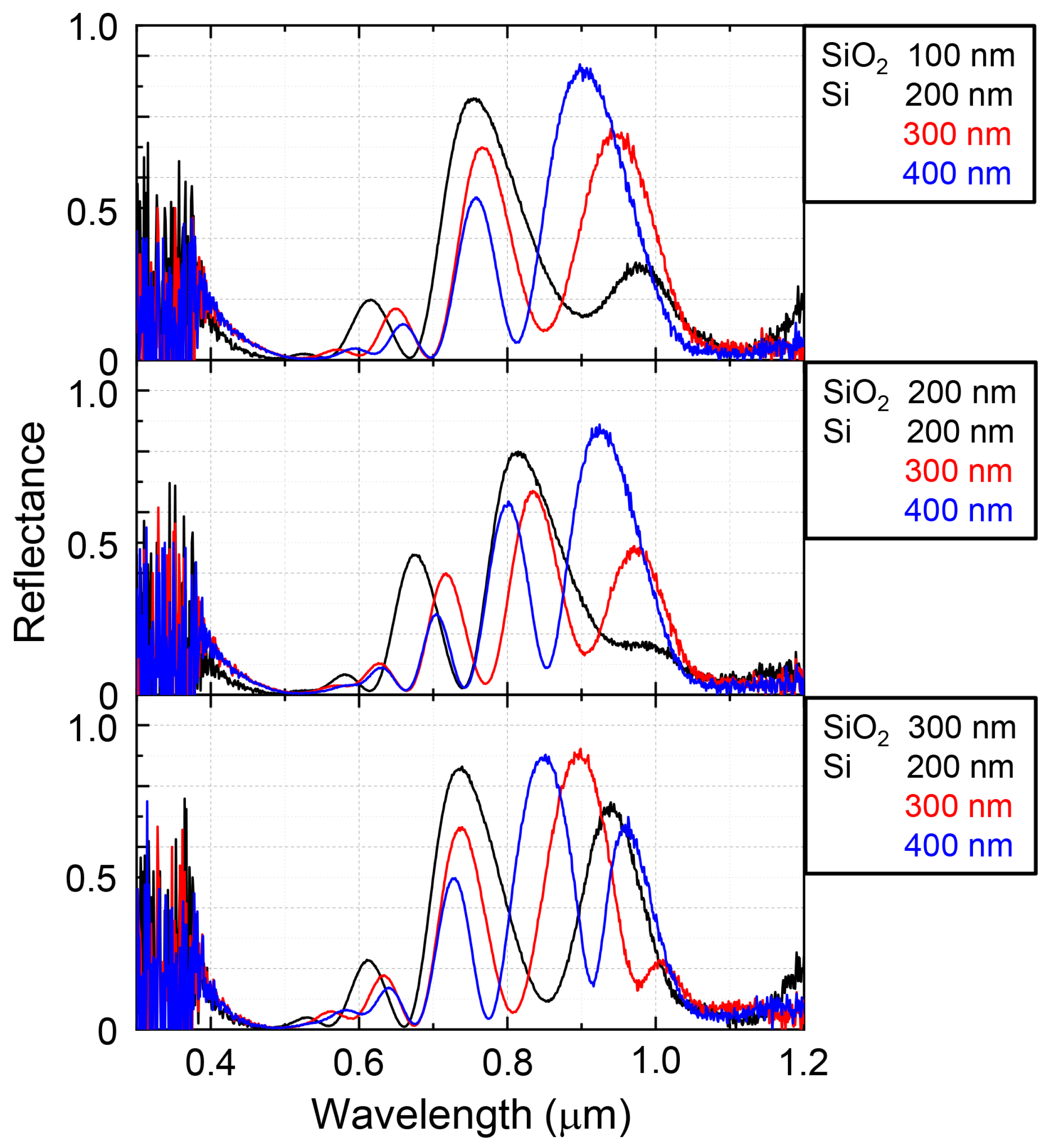
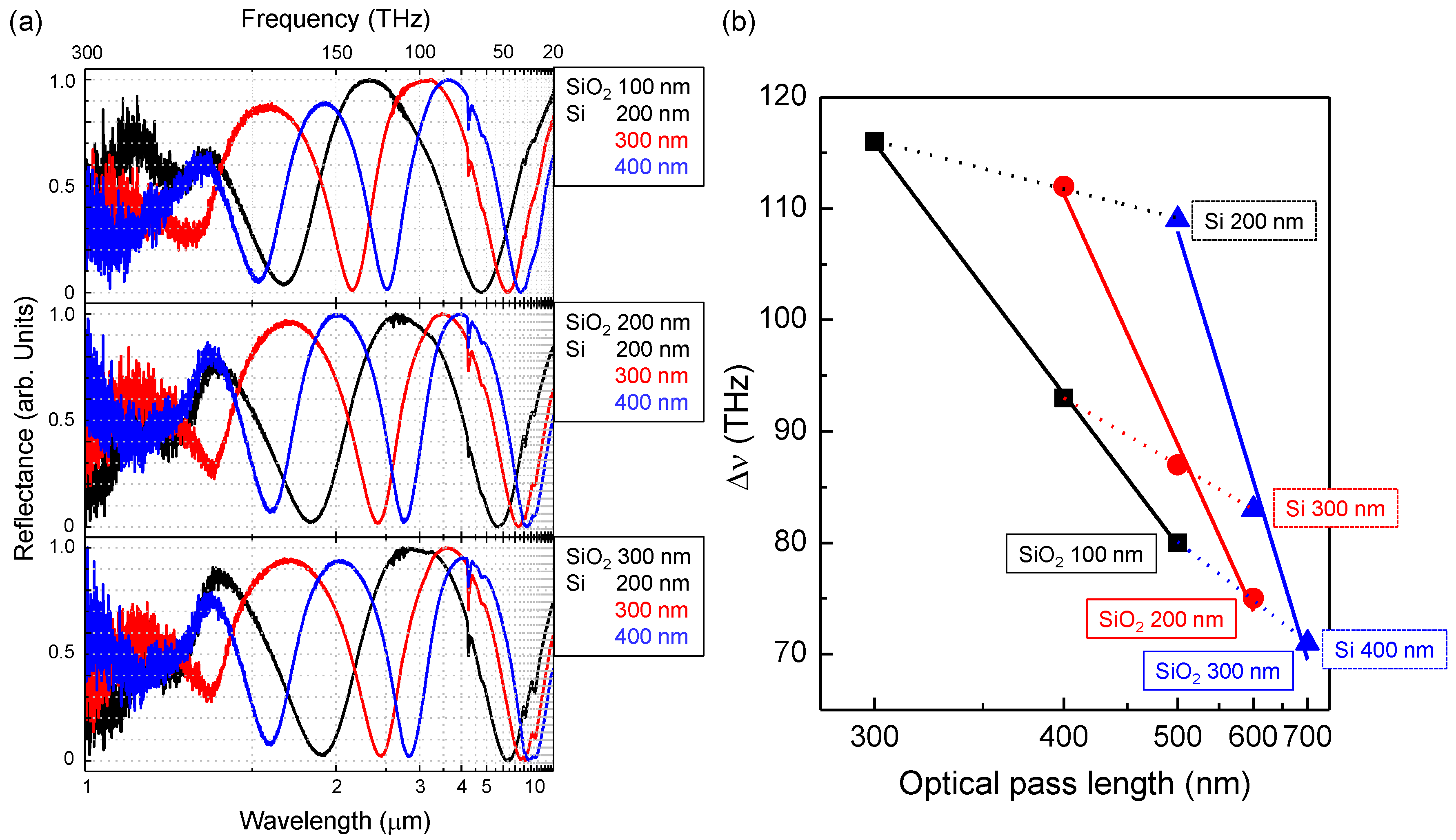
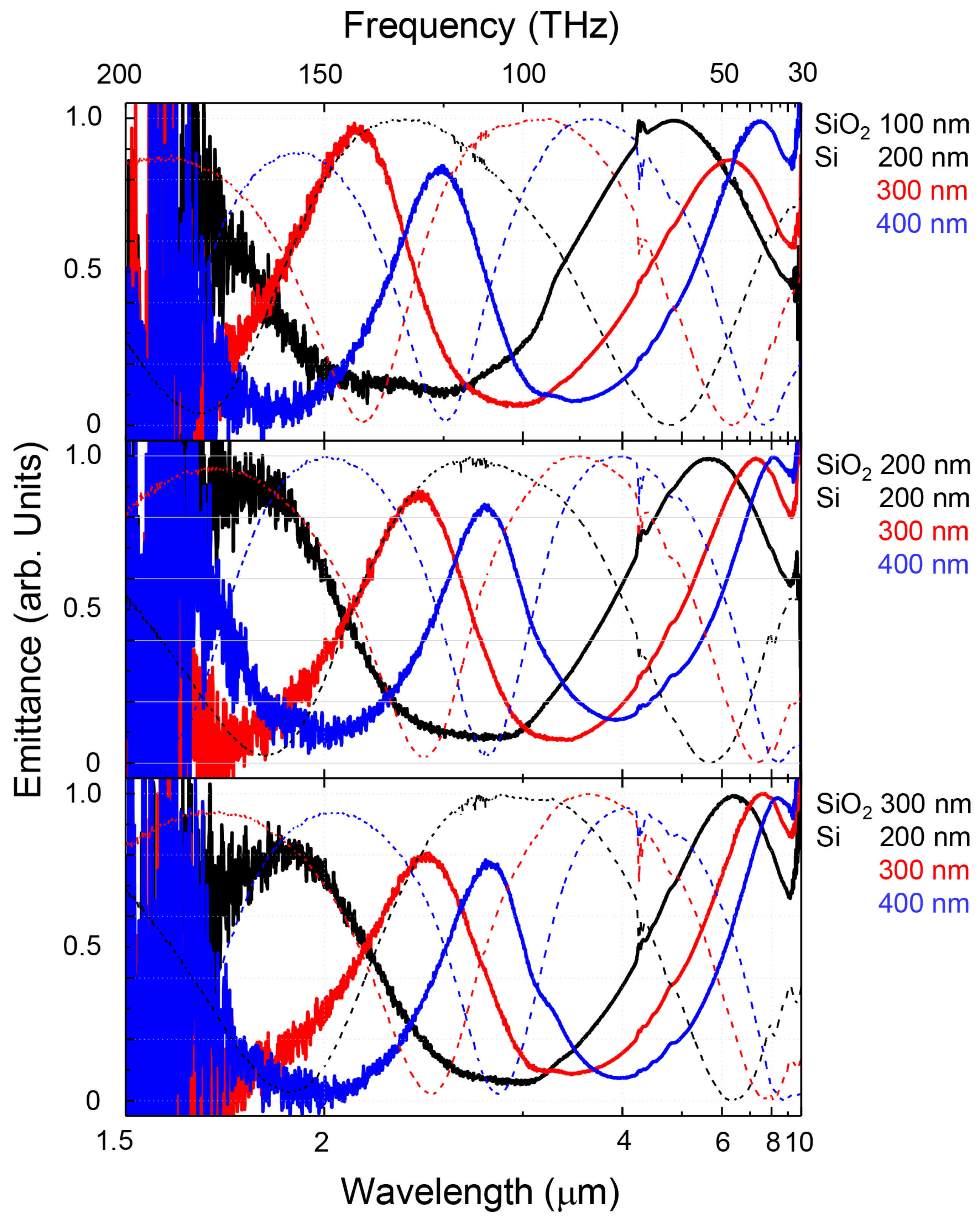
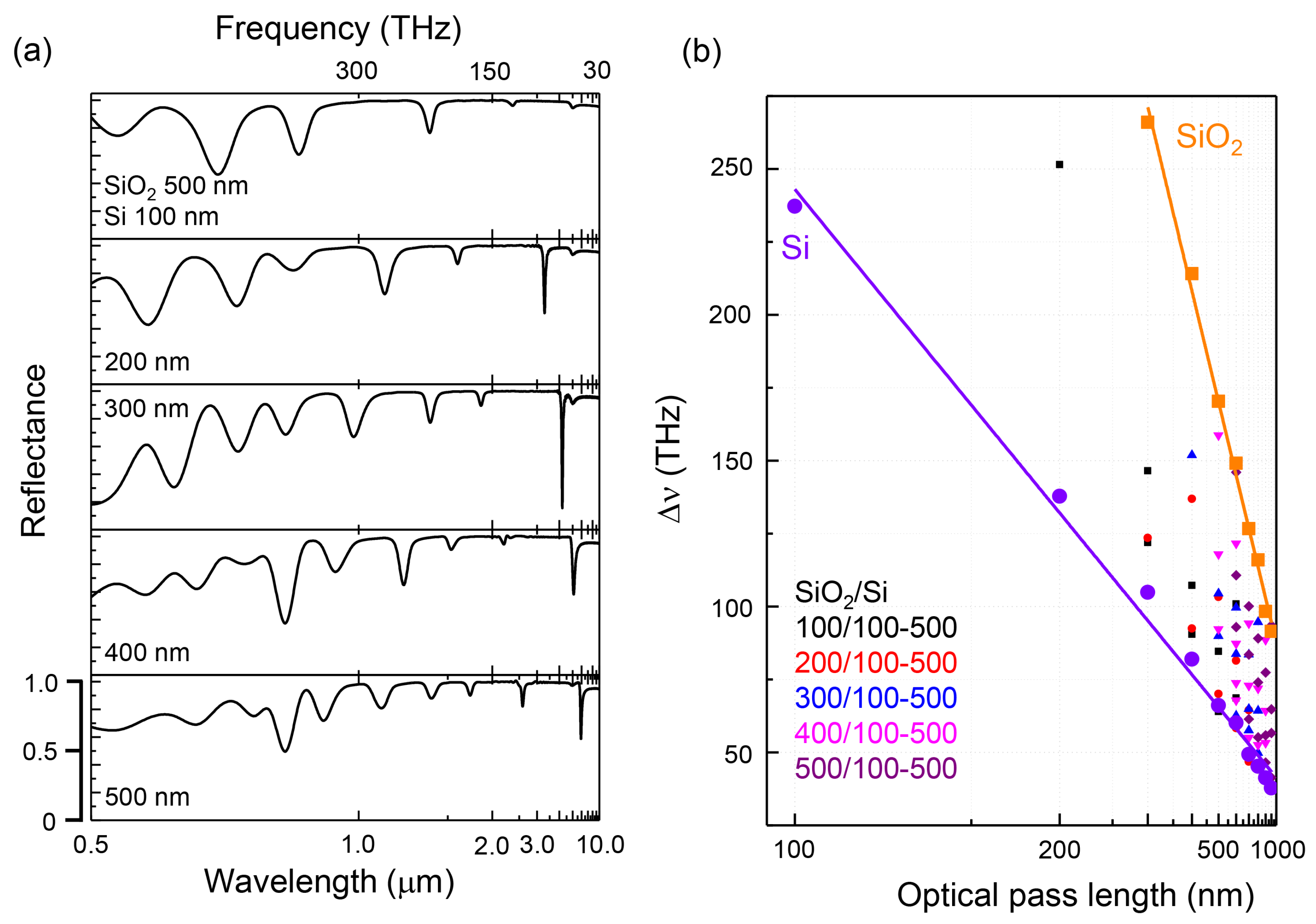
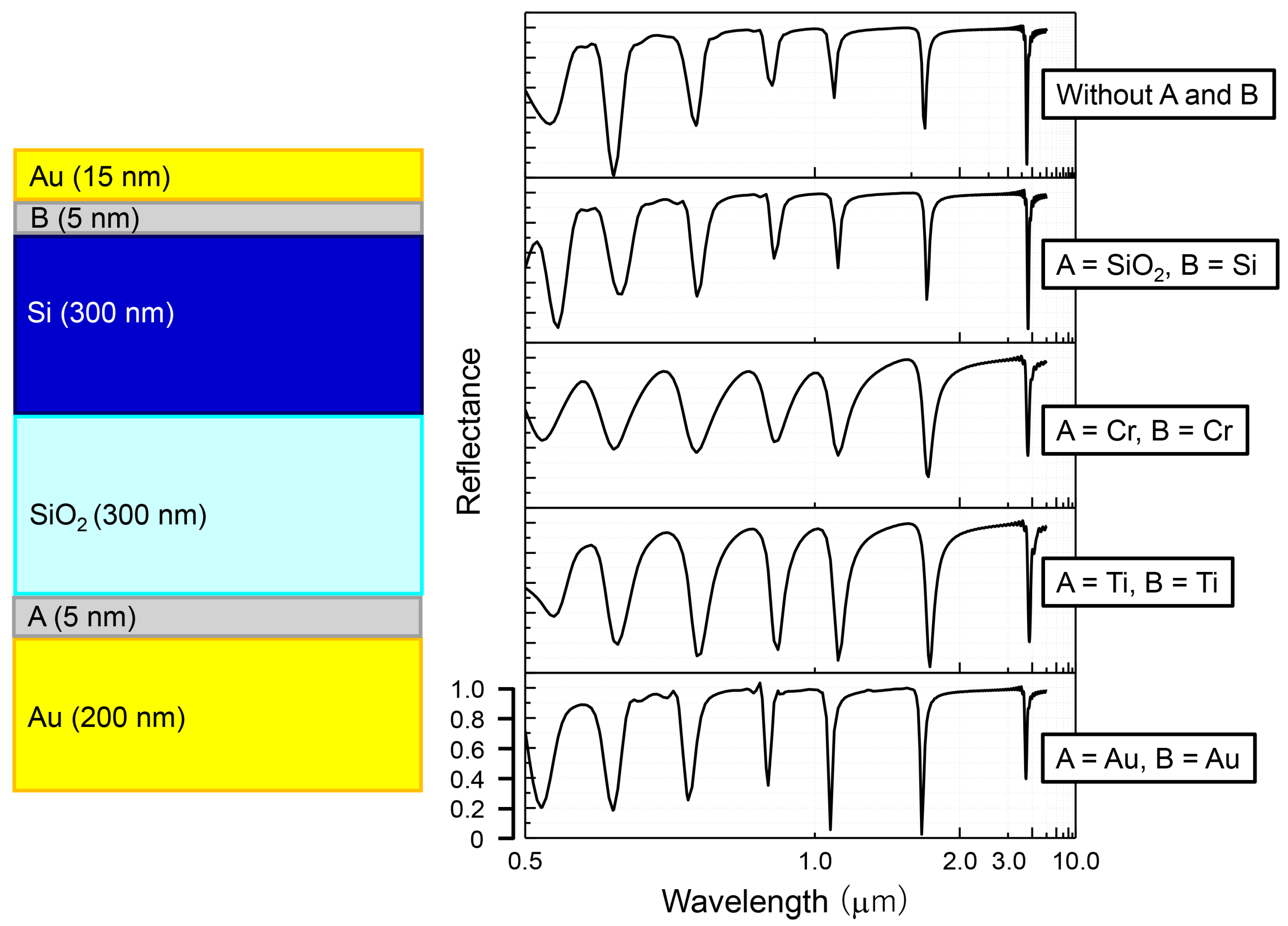
© 2020 by the authors. Licensee MDPI, Basel, Switzerland. This article is an open access article distributed under the terms and conditions of the Creative Commons Attribution (CC BY) license (http://creativecommons.org/licenses/by/4.0/).
Share and Cite
Kumagai, T.; To, N.; Balčytis, A.; Seniutinas, G.; Juodkazis, S.; Nishijima, Y. Kirchhoff’s Thermal Radiation from Lithography-Free Black Metals. Micromachines 2020, 11, 824. https://doi.org/10.3390/mi11090824
Kumagai T, To N, Balčytis A, Seniutinas G, Juodkazis S, Nishijima Y. Kirchhoff’s Thermal Radiation from Lithography-Free Black Metals. Micromachines. 2020; 11(9):824. https://doi.org/10.3390/mi11090824
Chicago/Turabian StyleKumagai, Takuhiro, Naoki To, Armandas Balčytis, Gediminas Seniutinas, Saulius Juodkazis, and Yoshiaki Nishijima. 2020. "Kirchhoff’s Thermal Radiation from Lithography-Free Black Metals" Micromachines 11, no. 9: 824. https://doi.org/10.3390/mi11090824
APA StyleKumagai, T., To, N., Balčytis, A., Seniutinas, G., Juodkazis, S., & Nishijima, Y. (2020). Kirchhoff’s Thermal Radiation from Lithography-Free Black Metals. Micromachines, 11(9), 824. https://doi.org/10.3390/mi11090824





